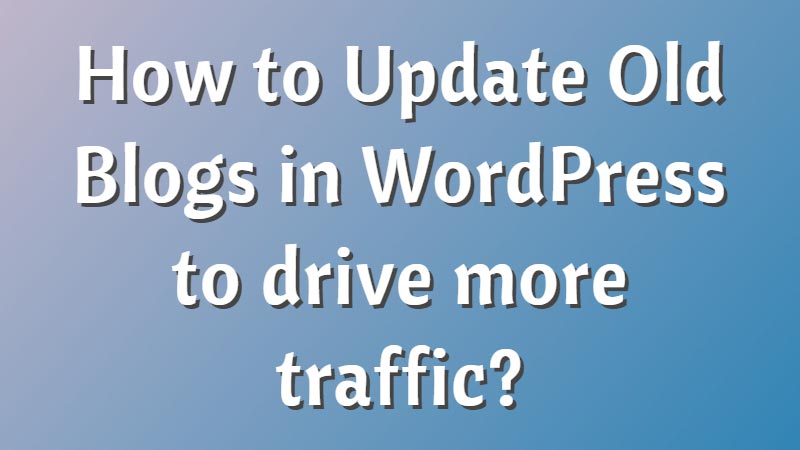Want to know how to update old blogs on your WordPress that can help you to drive traffic?
You have created your WordPress blog and now you are writing engaging content that is interesting and brings in more traffic. But as time passes some content is out of date and needs updating. Updating old blog posts will not only make your users active and avid readers they will trust you with the authenticity and accurate information that you provide to them.
In some cases, some statistics change in day-to-day life and you need to update the same on your blogs so that you won’t mislead your loyal readers.
If you are new to WordPress, maintaining a blog requires more than just churning out new posts. Updating and refreshing older content is a crucial aspect of keeping your blog relevant, engaging, and optimized for search engines. By revisiting and revitalizing your old blog posts, you can improve their quality, accuracy, and visibility, ultimately driving more traffic to your website and enhancing the overall user experience.
Revitalize Your WordPress Blog: Update Old Blogs to Drive Traffic

In this comprehensive guide, we’ll explore the step-by-step process of updating your old blog posts to ensure they remain valuable assets for your audience and your brand.
Step 1: Evaluate Your Existing Content
Before diving into updates, it’s essential to assess the current state of your blog. Review your older posts to identify which ones require updating. Look for content that may be outdated, inaccurate, or underperforming in terms of traffic and engagement.
Step 2: Prioritize Posts for Updates
Not all blog posts will require immediate attention. Prioritize your updates based on factors such as relevance, traffic potential, and keyword performance. Focus on posts that have the most significant impact on your website’s overall performance.
Step 3: Conduct Keyword Research
Keyword trends and search engine algorithms change over time. Perform fresh keyword research to identify relevant terms and phrases that can be incorporated into your updated blog posts. This will help improve their visibility and organic search rankings.
Step 4: Update Information
If your old blog posts contain outdated information, statistics, or references, it’s crucial to update them with the latest data and insights. This demonstrates your commitment to accuracy and keeps your content valuable to readers.
Step 5: Refresh Headlines and Meta Tags
Craft compelling headlines and meta descriptions that accurately reflect the content of your updated blog posts. Incorporate relevant keywords to improve search engine visibility and click-through rates.
Step 6: Optimize Content for SEO
Review the content of your old blog posts and make optimizations for search engine optimization (SEO). This may include adding relevant keywords, improving readability, and optimizing heading tags and image alt attributes.
Step 7: Add New Media
Enhance the visual appeal of your updated blog posts by adding new images, videos, infographics, or other multimedia elements. Visual content not only makes your posts more engaging but also helps break up long blocks of text. There are many royalty-free websites that you can find to add or update the images for your blogs.
Step 8: Incorporate Internal Links
Internal linking is an important SEO strategy that can help improve the visibility of your older blog posts. Identify relevant anchor text within your updated content and link to other relevant pages on your website.
Step 9: Check for Broken Links
Broken links can negatively impact the user experience and SEO of your blog. Use a tool or plugin to scan your old posts for broken links and update or remove them as necessary.
Step 10: Improve Readability and Formatting
Make sure your updated blog posts are easy to read and visually appealing. Break up long paragraphs, use subheadings to organize content, and incorporate bulleted lists or numbered lists for clarity.
Step 11: Update Call-to-Actions (CTAs)
If you create call-to-action buttons on your WordPress blogs, then review them within your old blog posts and ensure they are still relevant and effective. Consider updating CTAs to promote newer offers, products, or services.
Step 12: Incorporate User Feedback
If your old blog posts have received comments or feedback from readers, take this into account when updating them. Address any questions or concerns raised by readers and incorporate their insights to improve the quality of your content.
Step 13: Add Fresh Insights and Perspectives
Share new insights, perspectives, or experiences that have emerged since the original publication of your old blog posts. Adding fresh content helps keep your posts relevant and demonstrates your ongoing expertise in your niche.
Step 14: Update Publishing Dates
Changing the publishing date of your updated blog posts can signal to search engines that the content is fresh and relevant. However, use caution when updating dates to avoid confusing readers or misleading them about the freshness of the content.
Step 15: Monitor Performance Metrics
After updating your old blog posts, monitor performance metrics such as traffic, engagement, and search rankings. Analyze how the updates have impacted the performance of each post and make adjustments as needed.
Step 16: Promote Updated Content
Don’t forget to promote your updated blog posts across your marketing channels, including social media, email newsletters, and relevant online communities. Highlight the improvements and additions to encourage readers to revisit the content. There are ways to promote your blogs on social media platforms and you can boost them using paid promotion.
Step 17: Repurpose Content
Consider repurposing your updated blog posts into other formats, such as ebooks, podcasts, or videos. This allows you to reach new audiences and extend the lifespan of your content.
Step 18: Create a Schedule for Regular Updates
Establish a schedule for regularly reviewing and updating your old blog posts. This ensures that your content remains current and relevant over time, contributing to the long-term success of your blog.
Step 19: Seek Feedback
Encourage feedback from your audience regarding the updates to your old blog posts. Pay attention to comments, social media mentions, and other forms of feedback to gauge the effectiveness of your updates and identify areas for further improvement.
Step 20: Iterate and Improve
Content updates should be an ongoing process rather than a one-time task. Continuously monitor the performance of your blog posts, gather feedback, and make iterative improvements to ensure that your content remains valuable and impactful.
Every blogger updates their old blogs to drive more traffic so that they stay up-to-date with recent phenomena that are happening around the world. Updating your old blog posts is a strategic investment in the long-term success of your website and brand.
By following the steps outlined in this guide, you can breathe new life into existing content, improve its relevance and visibility, and provide greater value to your audience.
The Importance and Benefits of Updating Old Blog Posts

In the dynamic world of digital content creation, maintaining a blog is not just about churning out new posts regularly. It’s also about revisiting and updating older content to ensure its relevance, accuracy, and effectiveness. While the temptation to focus solely on generating fresh content is understandable, neglecting older blog posts can be a missed opportunity.
In this article, we’ll delve into the reasons why updating old blog posts is crucial for bloggers and businesses alike.
Enhancing Relevance and Accuracy
One of the primary reasons to update old blog posts is to ensure that the information presented remains accurate and relevant. Over time, industry trends evolve, statistics change, and new developments emerge. Content that was once informative and valuable may become outdated or even misleading if left unattended. By regularly revisiting and updating older posts, bloggers can maintain their credibility and provide readers with up-to-date, reliable information.
Improving Search Engine Optimization (SEO)
Search engines like Google value fresh and relevant content. By updating old blog posts with new information, keywords, and links, bloggers can improve their search engine rankings. Search engine algorithms prioritize content that is frequently updated and deemed valuable to users. Therefore, regularly refreshing older posts can help increase organic traffic to a blog and attract new readers.
Maximizing Content Value
Creating high-quality content is a time-consuming process. Rather than constantly churning out new posts, bloggers can maximize the value of their existing content by repurposing and updating older posts. By adding new insights, examples, or multimedia elements, bloggers can breathe new life into previously published content, reaching a wider audience and extending its lifespan.
Catering to Changing Audience Needs
Audience preferences and interests evolve over time. By updating old blog posts, bloggers can adapt to these changes and better serve their audience’s needs. Analyzing audience feedback, engagement metrics, and search queries can provide valuable insights into topics that require updating or expansion. By aligning content with audience interests, bloggers can enhance reader satisfaction and loyalty.
Building Authority and Trust
Consistently updating and maintaining a blog demonstrates a commitment to excellence and expertise within a particular niche. By regularly revisiting and improving older posts, bloggers can establish themselves as trusted authorities in their field. Building a reputation for reliable and informative content can lead to increased credibility, industry recognition, and opportunities for collaboration and monetization.
Reviving Evergreen Content
Some blog posts cover evergreen topics, meaning they remain relevant and valuable over time. However, even evergreen content can benefit from occasional updates to reflect new insights, examples, or perspectives. By refreshing evergreen content, bloggers can ensure that it continues to resonate with readers and remains competitive in search engine rankings.
Repositioning Content for New Platforms
As digital platforms and technologies evolve, bloggers may discover new opportunities to repurpose and redistribute their content. By updating old blog posts to align with the requirements of emerging platforms such as social media, podcasts, or video channels, bloggers can reach new audiences and diversify their content distribution strategy.
Leveraging Historical Performance Data
Analyzing historical performance data can provide valuable insights into which blog posts have been most successful in terms of traffic, engagement, and conversion rates. By identifying top-performing posts and updating them with fresh content or optimization strategies, bloggers can capitalize on past success and further amplify their impact.
Conclusion
We have learned the importance of updating old blogs and also know why you need to update old blogs. Embracing the process of updating old blog posts as an integral part of content strategy can yield significant benefits for bloggers and businesses alike, ensuring that their digital footprint remains vibrant, authoritative, and impactful.
With careful planning and execution, your updated blog posts can continue to drive traffic, engagement, and conversions well into the future.
Now over to you,
Did you update your old blogs to drive traffic to your WordPress site?
How much increase in traffic once you make changes to your old posts?
Please let us know your thoughts and follow us on Facebook and Twitter.
